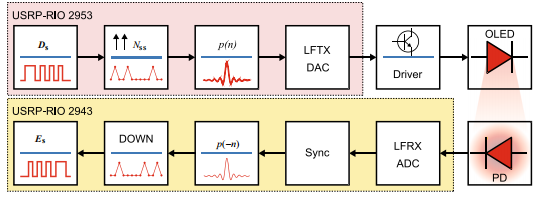Visible light communication (VLC) is a wireless technology that relies on optical intensity modulation and is potentially a game changer for internet-of-things (IoT) connectivity. However, VLC is hindered by the low penetration depth of visible light in non-transparent media. One solution is to extend operation into the “nearly (in)visible” near-infrared (NIR, 700–1000 nm) region, thus also enabling VLC in photonic bio-applications, considering the biological tissue NIR semitransparency, while conveniently retaining vestigial red emission to help check the link operativity by simple eye inspection. Here, we report new far-red/NIR organic light-emitting diodes (OLEDs) with a 650–800 nm emission range and external quantum effificiencies among the highest reported in this spectral range (>2.7%, with maximum radiance and luminance of 3.5 mW/cm2 and 260 cd/m2 , respectively). With these OLEDs, we then demonstrate a “real-time” VLC setup achieving a data rate of 2.2 Mb/s, which satisfifies the requirements for IoT and biosensing applications. These are the highest rates ever reported for an online unequalised VLC link based on solution-processed OLEDs.
In recent years, the increasing demand for faster data transmission speeds has shifted the attention of researchers from bandwidth-limited radio technologies to optical wireless communication systems1 , which offer “practically” unlimited bandwidth (>400 THz) by exploiting the ultraviolet to infrared region of the electromagnetic spectrum. Among these systems, VLC systems are appealing because of the possibility of leveraging the ubiquity of the light-emitting devices already used in countless commercial applications, ranging from lighting systems to mobile phones and TV displays.
When considering the downlink and uplink capacities, more robust transmitters (i.e., inorganic LEDs) are generally selected for the downlink since they currently offer higher power output than OLEDs, although in the future OLEDs may offer similar power levels and be an alternative. However, we envisage OLEDs integrated into lowcost, high-performance display technologies as the uplink in VLC-based 5G access links, whose standards currently defifine the downlink-to-uplink speed ratio as ranging from 4:1 to 8:1, depending on the traffific volume. Such a reduced throughput requirement, coupled with the SNRs and data rates demonstrated in our previous work, proves that data rates suffificiently high to satisfy uplink requirements can be supported.
Despite these hurdles, NIR OLEDs present some advantages compared with inorganic NIR emitters, offering both mechanical conformability and design freedom afforded by low-cost wet deposition methods. Crucially, organics also offer material design flflexibility, preferentially developed in the direction of heavy-metalfree materials because these materials are both more environmentally sustainable and biocompatible, and thus preferred for biomedical and/or food industry applications in which toxicity is an issue. Narrow-gap hybrid organic–inorganic materials and organometallic phosphorescent complexes, even those characterised by external quantum effificiencies (EQEs) exceeding 10%, are thus less appealing. Interestingly, EQEs in the 1–10% range have also been reported for devices incorporating heavy-metal-free (purely organic) NIR flfluorescent dyes. However, the most effificient of these approaches leverage, to a signifificant extent, triplet-tosinglet conversion (so-called triplet–triplet annihilation (TTA) or reverse inter-system crossing (rISC)) to obtain high effificiency, with a concomitant intrinsic limitation of the bandwidth even when the problems of the RC time constant can be overcome by reducing the device area. The maximum EQEs for NIR-emitting devices in which triplet leveraging plays a minor or no role have been limited to 1.2%.

Fig1
In the case of eDPP, both its ten-ring-fused rigid structure and the presence of flfluorene and diarylamino electron-donor units on either side of the electronaccepting DPP moiety afford extended electron delocalisation and a small energy gap (~1.8 eV, as measured via cyclic voltammetry, see Methods). Furthermore, the alkyl chains of the flfluorene units confer good solubility to eDPP in comparison to, for example, similar highly planar DPP ring-fused derivatives, thus crucially facilitating its incorporation into a polymeric matrix. Furthermore, the presence of two flfluorene units in the backbone makes eDPP suitable for blending into polyflfluorenic matrices to mitigate aggregation quenching and facilitate charge transport.
Among the plethora of flfluorene-based polymers available on the market, we selected F8BT as a matrix because the relatively deep-lying lowest unoccupied and highest occupied molecular orbital energy levels (LUMO and HOMO, respectively, essentially the equivalent of the conduction and valence bands for inorganic semiconductors) enable effificient electron injection (into the LUMO) and, concurrently, the favourable formation of a “so-called” type-I heterojunction with eDPP (Fig. 1c). Such a type-I heterojunction also proved effective with other dyes by favouring exciton localisation (in the emitter) over undesired exciton dissociation. Contrary to the case of eDPP, in F8BT, TTA and rISC contribute to the formation of a minority of singlet excitons (with subsequent transfer to eDPP) over a timescale of ~1 μs , but this does not compromise application to VLC, as most of the EL decay is prompt and only 10% of the initial intensity decays over timescales longer than a few hundreds of nanoseconds (vide infra).
上一篇: 硅片中高对比度光学波导的微加工
下一篇: 锑化镓物理与技术:一种新兴的光电材料